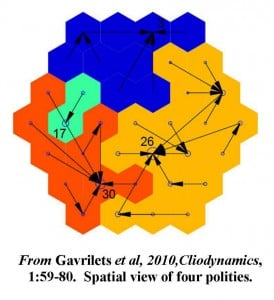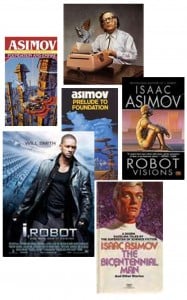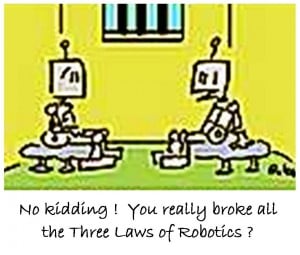I was preoccupied in this last three weeks of January about the bigger picture of how life and work might look like in 2011, mostly playing catch-up with work issues since a lot of things just got placed in my ‘waiting basket’ during the Holidays. I was also bothered by little things; especially about finding my old collection of science fiction books by Isaac Asimov called The Foundation Series, the first trilogy printed in the 1950’s. My kids typically classify my preoccupation with things and events of that era as the ‘dinosaur years.’ With a plethora of science fiction paperback novels and special effects movies in the last 10 years alone, why should I be interested in a similar genre written 60 years ago? Not sure what the answers is. Perhaps by the time I finish this tale of science fiction and real science we will both have the answer to this question.
As I rummage hopelessly through my ‘library’ (In my case defined as rooms full of books, manuscripts, articles and magazines scattered on the floor, on bookshelves and on top of tables, along with the smattering of half a dozen partially filled and almost empty cups of coffee for ‘decorative’ purposes), I decided to just glance over to my laptop to check out today’s smorgasbord of science news in scienceblog.com. And there it was! Not Asimov’s books, but an article published recently by Sergey Gavrilets (National Institute for Mathematical and Biological Synthesis) and co-authored by David G. Anderson (University of Tennessee-Knoxville) and Peter Turchin (University of Connecticut). The article “Cycling in the complexity of early societies” was among the first in the brand new journal called Cliodynamics: The Journal of Theoretical and Mathematical History, “the first academic journal to research from the emerging science of theoretical history and mathematics.”
That’s nice. But, where’s the connection to Asimov’s books? Let me tell you first what this article is all about as best as I can figure it out. I really am not a fan of anything mathematical, especially when it comes to theoretical population biology on which I still harbor occasional nightmares from grad school days. The start of the population biology class usually triggers also the start of my usual fantasy of being somewhere else—on a tropical beach, sipping margarita under a coconut tree, surrounded by native women wearing sarong– that is, when I wasn’t dozing off.
 Gavrilets developed a mathematical model, using hundreds of years of human historical data, to predict the rise and fall of complex societies. Through numerical simulations that take into account parameters such the size of the state, political power, length of rule, economic variables, etc, his team was able to explain the dynamic processes that cause kingdoms, states and empires to collapse on the scale of decades and centuries.
Gavrilets developed a mathematical model, using hundreds of years of human historical data, to predict the rise and fall of complex societies. Through numerical simulations that take into account parameters such the size of the state, political power, length of rule, economic variables, etc, his team was able to explain the dynamic processes that cause kingdoms, states and empires to collapse on the scale of decades and centuries.
Gavrilets concludes:
Over the past several decades mathematical methods and techniques have become very important in life sciences and social sciences. In particular, mathematical and computational modelings are powerful tools for better understanding the origins of new species and of general rules of biological diversification. Agent-based simulation modeling efforts like those advanced here offer fruitful avenues for future research on general patterns in historical dynamics and on the emergence and diversification of human societies.
Isaac Asimov
Much has been written about Asimov and thought I just give you a snapshot of his life and his works as a preamble to the next part of this narrative. Isaac Asimov (family name derived from the Russian word meaning winter grain—from his great grandfather’s occupation) was born in Russia as Isaak Yudovich Ozimov of Jewish ancestry, immigrated to United States at the age of 3 and later became one of the most prolific American writers of all time, with over 500 books to his credit. Not knowing the exact date of his birth due to the uncertainty between the Gregorian and Jewish calendars of the time, he simply decided that his birthday ought to be January 2, 1920. He would have been 90 years of age this month.
Young Isaac taught himself to read English at the age of five, taking advantage of the “pulp” science fiction magazines sold in his father’s candy store in Brooklyn, NY. (Pulp magazines, pulp fiction or simply ‘the pulps’ refer to cheap fiction magazines printed between 1896 through the 1950’s on cheap, ragged, untrimmed wood pulp paper. It was famous for being cheaper than the magazines called ‘glossies.’ Pulps mostly feature lurid, sensational, exploitive stories with colorful page covers. Comic book superheroes are considered descendants of pulp fiction). Though his father disapproved of pulp science fiction magazines, Isaac managed to convince him otherwise since he reasoned that the word ‘science’ was there and therefore must be ‘educational.’ By 11, he was already writing his own stories and by the age of 19 selling stories to science fiction magazines himself. Educated in the New York public school system, he eventually received his PhD in biochemistry from Columbia University in 1948. Along with Arthur C. Clarke and Robert A. Heinlein, Isaac Asimov is considered the master of science fiction during his life time.
 The words robotics, positronic (an entirely fictional technology) and psychohistory (also fictional) are all attributed to Asimov from his novels. Robotics and positronic continues to be part of American lexicon, most notably in movies, such as Star Trek; The Next Generation that featured androids with positronic brains. His robot stories which became part of the novel I, Robot in 1950 and made into a film in 2004 with Will Smith, described a set of ethical rules for robots (The Three Laws of Robotics) leading to other stories, such as the Bicentennial Man, also made into a movie starring Robin Williams. He became a friend and science advisor to Gene Roddenberry on many Star Trek projects.
The words robotics, positronic (an entirely fictional technology) and psychohistory (also fictional) are all attributed to Asimov from his novels. Robotics and positronic continues to be part of American lexicon, most notably in movies, such as Star Trek; The Next Generation that featured androids with positronic brains. His robot stories which became part of the novel I, Robot in 1950 and made into a film in 2004 with Will Smith, described a set of ethical rules for robots (The Three Laws of Robotics) leading to other stories, such as the Bicentennial Man, also made into a movie starring Robin Williams. He became a friend and science advisor to Gene Roddenberry on many Star Trek projects.
The Foundation Series
 Though Asimov had written history books (about the Greeks, Romans, Babylonians and Egyptians), mystery stories (in Ellery Queen’s Mystery Magazine), scholarly biblical works and countless science fiction stories, he is singularly remembered for his Foundation Series. This is where Gavrilets and Asimov converged in this narrative. The Foundation Series comprises seven science fiction novels, the first three, the Foundation Trilogy (Foundation, Foundation and Empire and Second Foundation) are considered the most famous and written in the early 1950’s. It wasn’t until 30 years later that he began writing again the 4th entry in the saga.
Though Asimov had written history books (about the Greeks, Romans, Babylonians and Egyptians), mystery stories (in Ellery Queen’s Mystery Magazine), scholarly biblical works and countless science fiction stories, he is singularly remembered for his Foundation Series. This is where Gavrilets and Asimov converged in this narrative. The Foundation Series comprises seven science fiction novels, the first three, the Foundation Trilogy (Foundation, Foundation and Empire and Second Foundation) are considered the most famous and written in the early 1950’s. It wasn’t until 30 years later that he began writing again the 4th entry in the saga.
The fictional story goes like this:
The setting is the universe thousands of years in the future when mankind, with a population in the quadrillions and ruled by a Galactic Empire, occupied millions of star systems in the galaxy. A mathematician named Hari Seldon developed a mathematical simulation, called psychohistory. The principle, based on the laws of mass action, numerically calculates the behavior of a quadrillion inhabitants (anything less is inaccurate) that enabled Seldon to predict the imminent collapse of the Empire. It also predicted that the collapse will follow a period of 30,000 years of descent to anarchy and barbarism, akin to the Dark Ages of medieval Europe, before the rise of the Second Empire. His mathematical modeling also predicted an alternative option with the Dark Ages lasting only 1,000 years, if a source of knowledge can fill the vacuum left by the collapse of the Empire and the technologies that created it. The Seldon Plan, which attempts to minimize the period of the Dark Ages, was to establish two cryptic societies, one at each opposite end of the Milky Way galaxy, populated by scientists and technocrats, called the Foundations, ready to step in as the Empire collapses. The Galactic Emperor found out about psychohistory and the adventures began…
Gavrilet and Asimov’s Hari Seldon
A science fiction writer conceives the idea from basic facts and then extrapolates from there, creating fantasies and visions not always possible in a real scientific discipline.
 There are times when the figment of a fiction writer’s fantasy decades before becomes a common reality now. Let’s take the case of the Star Trek television series of the late 60’s. The series described the interstellar adventures of Capt. Kirk, Mr. Spock, Dr. McCoy, a multi-ethnic crew (first time such an attempt was made in the racially charged era of the 1960’s) and the occasional alien crew member or guests in galactic starship Enterprise of the 22nd century. This unique TV series created the biggest ever fan base of science fiction enthusiasts (and that includes yours truly). Even NASA named its first space shuttle Enterprise in honor of the fictional galactic starship. Though the original airing of the TV series was not accessible to me then (I happened to be in an island in another continent at the time; and yes, no American TV), coming to America, I did grow up on the TV reruns of Gene Roddenberry’s vision of the future, many of which has come to fruition in my life time: mobile phones, pda, tablet PC, hand held diagnostic instruments (Mr. Spock’s tricorder), MRI (Dr. Spock’s diagnostic table), the jet injector for drugs (Dr. McCoy’s hypospray), the universal translator (now the voice recognition and language software), the telepresence device (now the video conferencing) and the phaser set to stun (now the Taser gun to immobilize), just to name a few. Even the truly far out concepts of the Romulan cloaking device, the transporter beam, the tractor beam, the energy shield to protect the starship are being researched seriously. New results from military and university research are paving the way for new materials to distort light to hide objects in plain sight, new methods transport small items by fragmenting molecules and electronic shield/counter strike weapons that destroy incoming projectiles, now featured in the more recent Israeli design for combat tanks.
There are times when the figment of a fiction writer’s fantasy decades before becomes a common reality now. Let’s take the case of the Star Trek television series of the late 60’s. The series described the interstellar adventures of Capt. Kirk, Mr. Spock, Dr. McCoy, a multi-ethnic crew (first time such an attempt was made in the racially charged era of the 1960’s) and the occasional alien crew member or guests in galactic starship Enterprise of the 22nd century. This unique TV series created the biggest ever fan base of science fiction enthusiasts (and that includes yours truly). Even NASA named its first space shuttle Enterprise in honor of the fictional galactic starship. Though the original airing of the TV series was not accessible to me then (I happened to be in an island in another continent at the time; and yes, no American TV), coming to America, I did grow up on the TV reruns of Gene Roddenberry’s vision of the future, many of which has come to fruition in my life time: mobile phones, pda, tablet PC, hand held diagnostic instruments (Mr. Spock’s tricorder), MRI (Dr. Spock’s diagnostic table), the jet injector for drugs (Dr. McCoy’s hypospray), the universal translator (now the voice recognition and language software), the telepresence device (now the video conferencing) and the phaser set to stun (now the Taser gun to immobilize), just to name a few. Even the truly far out concepts of the Romulan cloaking device, the transporter beam, the tractor beam, the energy shield to protect the starship are being researched seriously. New results from military and university research are paving the way for new materials to distort light to hide objects in plain sight, new methods transport small items by fragmenting molecules and electronic shield/counter strike weapons that destroy incoming projectiles, now featured in the more recent Israeli design for combat tanks.
Isaac Asimov’s fiction of a mathematician predicting the collapse of the Galactic Empire made a good the story. It was purely from the fantasies of Asimov’s fertile mind. But like in Star Trek, some fantasies eventually turn to something real—sometimes. Gavrilets’ numerical simulations do seem to show that such predictions can be possible. His paper certainly is an elegant piece of scientific work and will surely be controversial. Whether it can predict the collapse of empires, perhaps Gavrilets, like Hari Seldon, have to wait before mankind reach the quadrillion mark in the far flung reaches of a future galactic empire.
I wonder if Sergey Gavrilets ever read the Foundation trilogy. Had he been alive today, Isaac Asimov would have been ecstatic to read Gavrilets’ paper. Perhaps, I should ask Gavrilets about the Foundation novels if we ever meet one day. Not to talk about galactic futures, but about the recent collapses of dictatorial states and when future ones might be expected to follow the same path.
I think science fiction writers and mathematicians in sociobiology have one thing in common – they seem to chase after futuristic events.
I am sure Isaac Asimov would agree.
Jonathan R. Matias
Chief Science Officer
Poseidon Sciences Group
PS
Still looking for Asimov’s books !
SUGGESTED READING
https://scienceblog.com/41939/mathematical-model-explains-how-complex-societies-emerge-collapse/
Gavrilets S, Anderson D, Turchin P. 2010. Cycling in the complexity of early societies. Cliodynamics: The Journal of Theoretical and Mathematical History. 1:1
http://escholarship.org/uc/irows_cliodynamics?volume=1;issue=1
http://en.wikipedia.org/wiki/Foundation_series
http://en.wikipedia.org/wiki/Isaac_Asimov
http://www.tiem.utk.edu/~gavrila/Research.htm
http://electronics.howstuffworks.com/10-star-trek-technologies10.htm

